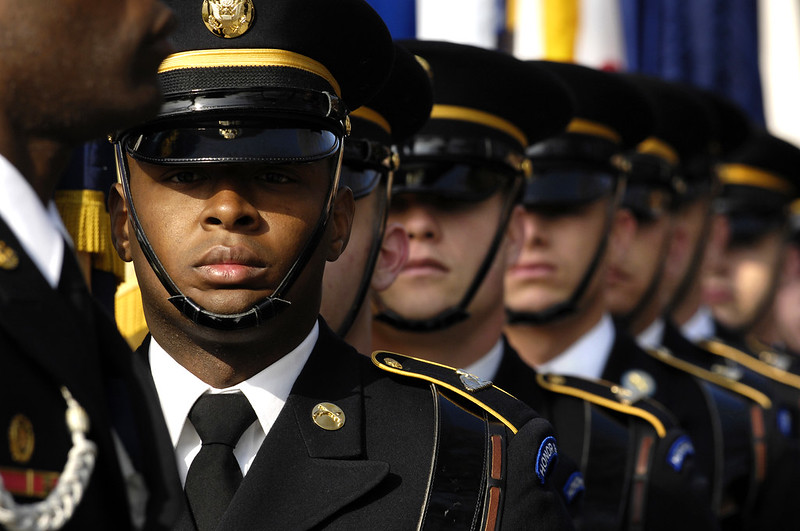
Maintaining the defense of our country may seem the least surprising thing to expect of government. And, to an extent, that’s right. Since we won independence, Americans have never assumed anyone other than elected leaders should have the power to enlist, train, and support soldiers and maintain a navy and air force.
But over the last two and a half centuries, nearly everything else about America’s defense has been fiercely debated, including the size of the armed forces and their mission, and even which governments should be responsible: the states or the federal government.
These debates go back to colonial times, when the British army and navy were nominally in charge of the colonies’ defense. Even then, though, the British military presence was limited. It grew during the French and Indian War and when the colonies themselves started acting up in the 1770s. But for the most part the colonies protected themselves with local militia, which able-bodied men under age 45 were obliged to join and serve in without pay.
Today we idealize colonial militia members as the “minutemen” who fought the British at Lexington and Concord in 1775. But, in truth, they were neither good soldiers nor dependable. When George Washington took command of American troops in the summer of 1775, he despaired at the slovenly, undisciplined militia men who made up most of his troops; they were, he confided to a friend, not “worth the bread they eat.” Worse, most served only for a year, and when that enlistment was up, they walked away, sometimes on the eve of battle.
Not surprisingly, Washington came away from the war convinced America could not depend on citizen soldiers. He argued in a 1783 pamphlet that it needed a professional, trained “standing army” under national command, supplemented by state militias. Others disagreed, and the debate over a national army vs. state militias became one of the most contentious at the Constitutional Convention in 1787. (Basically, Washington and his allies won, and you can see the results in Article 2, Section 8 of the Constitution.)
But an army to do what? And how large an army and navy? Until the 20th century, nearly everyone agreed the mission was to fight occasional wars with foreign powers, including the British (War of 1812) and Mexicans (the Mexican War), and to save the Union during the mother of all American wars, the Civil War. Many supported military campaigns in the West against Native Americans, as well, as morally suspect as they were. But all these conflicts took place on the North American continent, and that was as far as most Americans were willing to let the military go.
The debate over the military’s mission began changing after the Spanish American War of 1898, when America, to the surprise of many, came to “own” territories from the Philippines to Puerto Rico and, later, the Canal Zone in Panama. These overseas territories caused some in the early 20th century to rethink not only the geography but the size of America’s peacetime forces.
As World War I broke out in Europe in 1914, the advocates of a world role for America and a robust military became known as the “preparedness” movement. Their opponents, who argued that America should be concerned only about the homeland and did not need a large military, were called the “isolationists.” The debate between these groups raged for a quarter-century, pausing when America entered the war in 1917 and resuming when peace returned in 1918.
World War II put an end to the debate, as America became leader of an international coalition that defeated fascism and, after the war, contained Communism. There were tragedies along the way, like the Vietnam War, but the strategy of containment succeeded when Communism collapsed in Russia and Eastern Europe in the late 1980s.
So where does this leave us today? Still armed to the teeth. The United States spent $581 billion on its military in 2014, more than the next nine most heavily armed countries combined. (China was second at $129 billion.) But as a share of America’s economy, military spending has been declining for many years. In 1960, the U.S. spent 8.3 percent of its gross domestic product on its armed forces; in 2016 it was 3.3 percent.
There are still debates about the size of the military and its mission, though not as contentious as in the past. And we have maintained some degree of shared responsibility between the federal government and the states, which host National Guard units (the successors to the state militias). But throughout our history as a nation, soldiers, sailors, and airmen have served under the command of elected leaders and have respected the principle of civilian command. And for that, we can thank government.
More information:
https://en.wikipedia.org/wiki/United_States_Department_of_Defense
https://www.rand.org/content/dam/rand/pubs/research_reports/RR1700/RR1759/RAND_RR1759.pdf
https://teachinghistory.org/history-content/ask-a-historian/24671
https://science.howstuffworks.com/national-guard.htm
Give the credit to: federal government 90%, state governments 10%
Photo by The U.S. Army licensed under Creative Commons.
Leave a Reply